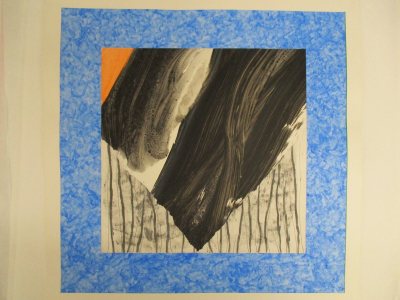What Makes a Presentation Better

William Manning Untitled #1027 Mixed media on paper 16 x 16 inches
Since I started working as an Education Intern at the Bates College Museum of Art, I have been thinking quite a bit about what the function of a museum is. In my very first few meetings with Anthony Shostak, the museum’s education curator, I remember discussing that museums are responsible for the collection, conservation, and interpretation of objects. However, from my experience this Winter Semester, there seems to be more than these ingredients in the inner-workings of a museum. At its core, a college museum such as Bates’s is community-oriented. After this semester, it is clear to me that any education department must ask itself the question: who are we educating? I soon found out that my job required me to do more than interpret, but ask questions.
My most complicated responsibility this semester was to give two short talks to 250 fourth-graders. The event, called Rollin’ to Olin, challenged me to rethink my ways of speaking, my art historical background, and my personal interests. It was challenging to even start to answer the question of what would be relevant for them that could be presented in the short period of 25 minutes in which I would have their undivided attention. Early in the semester, Anthony suggested I read Visual Thinking Strategies: Using Art to Deepen Learning Across School Disciplines, by Philip Yenawine. Primarily and foremost, the book defended that audience engagement is a key component of information retention. With scientific information backing it up, the primary goal of Visual Thinking Strategies was to craft effective ways to engage your audience and lead discussions.
As one of the core texts of many education departments today, Visual Thinking Strategies helped me immensely. My first question for the audience at my Rollin’ to Olin presentations was always, “What is going on in this picture?” Having the students come up with their own interpretation gave me a starting point from which to push their understanding forward. Yenawine suggested that questions such as, “How do you see that?” allow the students to ground their ideas on evidence. Moreover, the book reiterated the importance of using constructive language, such as saying, “What more do you see?” rather than asking, “What else do you see?” The author argues that the word “else” may give the idea that the educator is working towards a specific point rather than engaging with the students’ original inferences. Moreover, Yenawine also suggests that it is a good idea to always restate the input of your audience out loud. Taking the author’s suggestion, I was able to make sure I had understood their analyses. This also allows the students to develop a broader vocabulary without ever being corrected; on the contrary, they feel heard. It was based on these ideas that Anthony and I cooked up this semester’s Rollin to Olin presentations.
While Visual Thinking Strategies was fermenting in my head, I started researching the museum’s database and catalogs to select which pieces of art I would present. Anthony and I visited storage a number of times prior to deciding which colorful and engaging pieces were the best to get the audience thinking deeply about visual imagery. For the first presentation, I focused on works by Lewiston-born artists Charles Hewitt and William Manning. I hoped the large, colorful abstractions would engage the students with liveliness and a sense of place. For the second Rollin’ to Olin, Anthony and I decided to explore how artists visualize invisible phenomena such as sound and music. My hope was that students would think deeply about how patterns, volume, mood, harmony, and melody can be represented visually. A good deal of work went into searching for material that was engaging, complementary to the concept of the presentation, and with rights of reproduction owned by the museum.
At the early hour of 9 a.m., it was time to get started with the presentation Anthony and I had been cooking up. I already had art-inclined students pre-selected from each middle school who would join me onstage and be eager to share their views. However, wanting to create a sense of investment among the audience, I asked for three volunteers to join me onstage, and I had never seen hands rise that fast! They were none the wiser that their teachers had already given me a short-list. While I occasionally pointed my audience towards specific art historical facts, most of my role as a presenter was to take my volunteers’ interpretations a step further. Both presentations were challenging, but extremely rewarding. I was inspired to create something with children who were not unlike I was a few years ago. I found that stirring up conversation can be fun. Suddenly, rather than a forgettable presentation, I got to talk to 250 L/A middle schoolers about why William Manning’s Untitled 1027 painting resembles a landscape more than it resembles a piece of bacon. It was an experience I’ll be able to chew on and savor for some time.
Ariel Abonizio, ’20
Art & Visual Culture and Anthropology Double Major